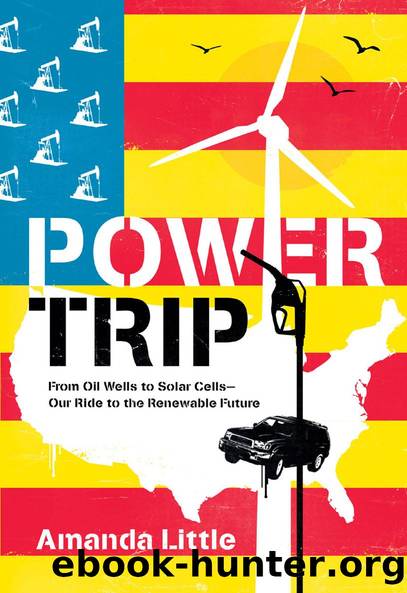Power Trip by Amanda Little

Author:Amanda Little [Little, Amanda]
Language: eng
Format: epub
Tags: Social Science, General, Nature, Environmental Conservation & Protection
ISBN: 9780061885143
Google: 87hTEo9ENa4C
Publisher: Harper Collins
Published: 2009-11-03T05:36:02+00:00
CURRENT AFFAIRS
As with everything else about the 1950sâthe era of chrome-finned cars and suburban utopiasâAmericaâs embrace of electricity use in that decade was wholehearted and lavish. Electrical appliances began to pervade American homes. Window air conditioner units appeared, with sales escalating from 74,000 in 1948 to 1,045,000 in 1953. Vacuum cleaner models were upgraded from costly, clunky units rarely found in homes to powerful, svelte, standup devices. New and improved refrigerators were billed as âquiet marvels of convenience.â Television came of age: in 1946, fewer than 1 percent of American homes owned TV sets, while by 1962, that number had reached 90 percent. Specialized widgets were invented for virtually every domestic chore imaginable, from electric can openers to plug-in baby-bottle sterilizers to chafing dishes advertised as âperfect for Welsh rarebit.â âIn 1960, the average American home sported a dozen electric appliances,â noted historian Richard Munson, âdouble the number of a decade before.â
Despite its promise to liberate women from housework, the Golden Age of electricity created so many more household tasks that at first it actually tethered them closer to home. Betty Friedan wrote of this constraint in her 1963 bestseller The Feminine Mystique, in which she chronicled the ânameless, aching dissatisfactionâ of the American housewife in the 1950s: âMillions of women lived their lives in the image of those pretty pictures of the American suburban housewife, kissing their husbands goodbye in front of the picture window, depositing their station wagons full of children at school, and smiling as they ran the new electric waxer over the spotless kitchen floor. They baked their own bread, sewed their own and their childrenâs clothes, kept their new washing machines and dryers running all day.â
Rather than creating a female workforce, electricity initially served to create a female consumer forceâvastly multiplying the number of products available, while television ads lured housewives to shopping malls. It wasnât until the 1960s, when the novelty of electrified goods had worn off, that the social benefits of electricity began to emerge. Between 1955 and 1975, womenâs participation in the workforce jumped from 40 percent to 55 percent. This was a revolution tied in part to social trends, including the feminist movement Friedan helped to foster, but technology also played a role: the average amount of time women spent on domestic chores in the 1960s and â70s dropped âfrom 52 hours a week in 1965 to 45 hours per week in 1975, and stayed relatively constant after that,â according to a study by researchers at the University of California, San Diego.
Electricity also led to a shift in the types of positions held by working women. The number of people employed in housekeeping jobs dropped precipitously throughout the 1950s and â60s, a result both of the increased use of home appliances and the emergence of better-paying skilled jobs in the booming manufacturing sector. The possibilities created by the power industry in this era of change seemed limitless. The sixties brought with them the Beatles, Jimi Hendrix, Chuck Berry, and other legendary
Download
This site does not store any files on its server. We only index and link to content provided by other sites. Please contact the content providers to delete copyright contents if any and email us, we'll remove relevant links or contents immediately.
Whiskies Galore by Ian Buxton(41937)
Introduction to Aircraft Design (Cambridge Aerospace Series) by John P. Fielding(33090)
Small Unmanned Fixed-wing Aircraft Design by Andrew J. Keane Andras Sobester James P. Scanlan & András Sóbester & James P. Scanlan(32763)
Craft Beer for the Homebrewer by Michael Agnew(18194)
Turbulence by E. J. Noyes(7977)
The Complete Stick Figure Physics Tutorials by Allen Sarah(7336)
Kaplan MCAT General Chemistry Review by Kaplan(6899)
The Thirst by Nesbo Jo(6877)
Bad Blood by John Carreyrou(6581)
Modelling of Convective Heat and Mass Transfer in Rotating Flows by Igor V. Shevchuk(6406)
Learning SQL by Alan Beaulieu(6236)
Weapons of Math Destruction by Cathy O'Neil(6213)
Man-made Catastrophes and Risk Information Concealment by Dmitry Chernov & Didier Sornette(5951)
Digital Minimalism by Cal Newport;(5700)
Life 3.0: Being Human in the Age of Artificial Intelligence by Tegmark Max(5509)
iGen by Jean M. Twenge(5384)
Secrets of Antigravity Propulsion: Tesla, UFOs, and Classified Aerospace Technology by Ph.D. Paul A. Laviolette(5332)
Design of Trajectory Optimization Approach for Space Maneuver Vehicle Skip Entry Problems by Runqi Chai & Al Savvaris & Antonios Tsourdos & Senchun Chai(5037)
Pale Blue Dot by Carl Sagan(4950)
